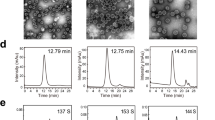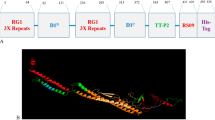Abstract
To increase the potency of human papillomavirus (HPV) DNA vaccines, we constructed a series of HPV16 L1 vaccines genetically fused with a secretion signal and/or immune cell-recruiting RANTES. The DNA vaccines encoding secretory HPV L1 were constructed by inserting HPV L1 gene into a vector with an ER-targeting secretory signal sequence. The expression plasmid encoding secretory HPV L1 (pER/L1) was fused with cDNA of RANTES, generating pER/L1/R. For comparison, HPV L1 genes were cloned into pVAX1 vector with no signal sequence (pL1), and further linked to the N-terminus (pL1/R) or C-terminus of RANTES (pR/L1). The secretion of L1 proteins was observed in the pER/L1, pER/L1/R, and pR/L1-transfected cells, except the pL1/R-transfected group. Cytoplasmic localization of L1 protein was observed in the cells transfected with pL1/R, but not with pER/L1/R at 48 h after transfection. In mice, RANTES-fused vaccines more effectively elicited the levels of HPV16 L1-specific IgG and IgG2a antibodies than pL1. Of RANTES-fused vaccines, pER/L1/R encoding the secreted fusion protein induced the highest humoral and CD8+ T-cell-stimulating responses. These results suggest that the immunogenicity of HPV L1 DNA vaccines could be enhanced by genetic fusion to a chemokine and secretory signal peptide sequences.
This is a preview of subscription content, access via your institution
Access options
Subscribe to this journal
Receive 12 print issues and online access
$259.00 per year
only $21.58 per issue
Buy this article
- Purchase on Springer Link
- Instant access to full article PDF
Prices may be subject to local taxes which are calculated during checkout





Similar content being viewed by others
References
Tjiong MY et al. Epidemiologic and mucosal immunologic aspects of HPV infection and HPV-related cervical neoplasia in the lower female genital tract. Int J Gynecol Cancer 2001; 11: 9–17.
Giannoudis CS, Herrington CS . Human papillomavirus variants and squamous neoplasia of the cervix. J Pathol 2001; 193: 295–302.
Rocha-zavalta L, Alejandre JE, Garcia-carranca A . Parenteral and oral immunization with a plasmid DNA expressing the human papillomavirus 16 L1 gene induces systemic and mucosal antibodies and cytotoxic T lymphocyte responses. J Med Virol 2002; 66: 86–95.
Mckenzie BS et al. Nucleic acid vaccines: tasks and tactics. Immunol Res 2001; 24: 225–244.
Boyle JS, Koniaras C, Lew AM . Influence of cellular location of expressed antigen on the efficacy of DNA vaccination: cytotoxic T lymphocyte and antibody responses are suboptimal when antigen is cytoplasmic after intramuscular DNA immunization. Int Immunol 1997; 9: 1897–1906.
Boyle JS, Brady JL, Lew AM . Enhanced responses to a DNA vaccine encoding a fusion antigen that is directed to sites of immune induction. Nature 1998; 392: 408–411.
Biragyn A et al. Genetic fusion of chemokines to a self tumor antigen induces protective, T-cell dependent antitumor immunity. Nat Biotechnol 1999; 17: 253–258.
Solari R et al. Receptor-mediated endocytosis of CC-chemokines. J Biol Chem 1997; 272: 9617–9620.
Mueller A, Kelly E, Strange PG . Pathways for internalization and recycling of the chemokine receptor CCR5. Blood 2002; 99: 785–791.
Oh YK, Swanson JA . Different fates of phagocytosed particles after delivery into macrophage lysosomes. J Cell Biol 1996; 132: 585–593.
Sasagawa T et al. Synthesis and assembly of virus-like particles of human papillomaviruses type 6 and type 16 in fission yeast Schizosaccharomyces pombe. Virology 1995; 206: 126–135.
Tobery TW et al. A simple and efficient method for the monitoring of antigen-specific T cell responses using peptide pool arrays in a modified ELISpot assay. J Immunol Methods 2001; 254: 59–66.
Lillard JW Jr et al. RANTES potentiates antigen-specific mucosal immune responses. J Immunol 2001; 166: 162–169.
Weiss R et al. Improvement of the immune response against plasmid DNA encoding OspC of Borrelia by an ER-targeting leader sequence. Vaccine 2000; 18: 815–824.
Fischer FR et al. RANTES-induced chemokine cascade in dendritic cells. J Immunol 2001; 167: 1637–1643.
Sadeghi H et al. Genetic fusion of human insulin B-chain to the B-subunit of cholera toxin enhances in vitro antigen presentation and induction of bystander suppression in vivo. Immunology 2002; 106: 237–245.
Ward SG, Westwick J . Chemokines: understanding their role in T-lymphocyte biology. Biochem J 1998; 333: 457–470.
Barash S, Wang W, Shi Y . Human secretory signal peptide description by hidden Markov model and generation of a strong artificial signal peptide for secreted protein expression. Biochem Biophys Res Commun 2002; 294: 835–842.
Sin J et al. DNA vaccines encoding interleukin-8 and RANTES enhance antigen-specific Th1-type CD4(+) T-cell-mediated protective immunity against herpes simplex virus type 2 in vivo. J Virol 2000; 74: 11173–11180.
Pete I et al. Detection of high-risk HPV (16, 18, 33) in situ cancer of the cervix by PCR technique. Eur J Gynaecol Oncol 2002; 23: 74–78.
Acknowledgements
This work was supported by Korea Research Foundation Grant (KRF 2001-015-FP0128).
Author information
Authors and Affiliations
Rights and permissions
About this article
Cite this article
Kim, S., Lee, C., Lee, S. et al. Enhanced immunogenicity of human papillomavirus 16 L1 genetic vaccines fused to an ER-targeting secretory signal peptide and RANTES. Gene Ther 10, 1268–1273 (2003). https://doi.org/10.1038/sj.gt.3301997
Received:
Accepted:
Published:
Issue Date:
DOI: https://doi.org/10.1038/sj.gt.3301997



